
Apidae is the largest family within the superfamily Apoidea, containing at least 5700 species of bees. The family includes some of the most commonly seen bees, including bumblebees and honey bees, but also includes stingless bees, carpenter bees, orchid bees, cuckoo bees, and a number of other less widely known groups. Many are valuable pollinators in natural habitats and for agricultural crops.

Sceliphron caementarium, also known as the yellow-legged mud-dauber wasp, black-and-yellow mud dauber, or black-waisted mud-dauber, is a species of sphecid wasp. There are some 30 other species of Sceliphron that occur throughout the world, though in appearance and habits they are quite similar to S. caementarium.

Apocrita is a suborder of insects in the order Hymenoptera. It includes wasps, bees, and ants, and consists of many families. It contains the most advanced hymenopterans and is distinguished from Symphyta by the narrow "waist" (petiole) formed between the first two segments of the actual abdomen; the first abdominal segment is fused to the thorax, and is called the propodeum. Therefore, it is general practice, when discussing the body of an apocritan in a technical sense, to refer to the mesosoma and metasoma rather than the "thorax" and "abdomen", respectively. The evolution of a constricted waist was an important adaption for the parasitoid lifestyle of the ancestral apocritan, allowing more maneuverability of the female's ovipositor. The ovipositor either extends freely or is retracted, and may be developed into a stinger for both defense and paralyzing prey. Larvae are legless and blind, and either feed inside a host or in a nest cell provisioned by their mothers.

Halictidae is the second-largest family of bees with nearly 4,500 species. They are commonly called sweat bees, as they are often attracted to perspiration. Halictid species are an extremely diverse group that can vary greatly in appearance. These bees occur all over the world and are found on every continent except Antarctica. Usually dark-colored and often metallic, halictids are found in various sizes, colors and patterns. Several species are all or partly green and a few are red, purple, or blue. A number of them have yellow markings, especially the males, which commonly have yellow faces, a pattern widespread among the various families of bees. The family is one of many with short tongues and is best distinguished by the arcuate basal vein found on the wing. Females in this family tend to be larger than the males.
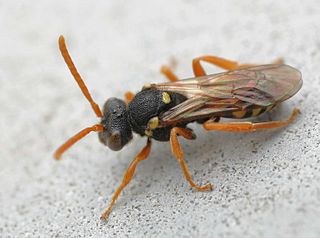
Nomadinae is a subfamily of bees in the family Apidae. They are known commonly as cuckoo bees.

Habropoda laboriosa, the southeastern blueberry bee, is a bee in the family Apidae. It is native to the eastern United States. It is regarded as the most efficient pollinator of southern rabbiteye blueberries, because the flowers require buzz pollination, and H. laboriosa is one of the few bees that exhibit this behavior. It is active for only a few weeks of the year, while the blueberries are in flower during early spring, when the temperature is warm and humid. H. laboriosa are solitary bees that live alone but nest in close proximity with other nests of their species. They have similar features to bumble bees, but they are smaller in size compared to them. H. laboriosa are arthropods so they have segmented bodies that are composed of the head, thorax, and abdomen.
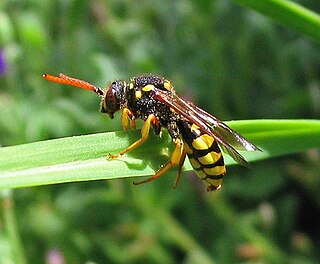
With over 850 species, the genus Nomada is one of the largest genera in the family Apidae, and the largest genus of cuckoo bees. Cuckoo bees are so named because they enter the nests of a host and lay eggs there, stealing resources that the host has already collected. The name "Nomada" is derived from the Greek word nomas, meaning "roaming" or "wandering."
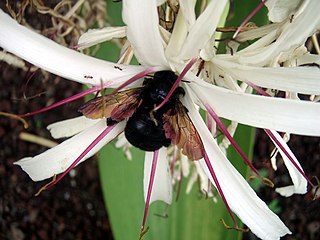
Xylocopa sonorina, the valley carpenter bee or Hawaiian carpenter bee, is a species of carpenter bee found from western Texas to northern California, and the eastern Pacific islands. Females are black while males are golden-brown with green eyes.

Macropis is a genus of bees in the family Melittidae.
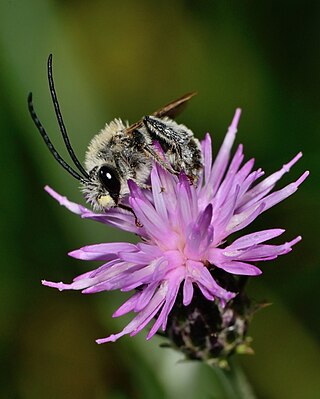
Eucera is a genus of bees in the family Apidae, which comprises more than 100 species. These bees are commonly known as long-horned bees due to their characteristically long antennae, especially in males. Eucera species can be found in diverse habitats, including meadows, fields, and urban gardens, primarily in the Palearctic and Nearctic regions, covering parts of Europe, Asia, North Africa, and North America.

Sphecodopsis is a genus of cleptoparasitic cuckoo bees in the family Apidae. Endemic to southern Africa, the wasp-like bees of this genus are generally small, varying from 3.9 to 9 mm in length, and mostly black, with orange-ish or reddish colouring of the metasoma in some of the species. The bee genus Scrapter is recognised as a host for the cleptoparasitic life cycle of some Sphecodopsis, but further data regarding preferred hosts is not available for most of the species.

Ptilothrix is a genus within the tribe Emphorini of the family Apidae. Bees of this genus can range from 7 to 15 mm. Ptilothrix species are solitary, ground-nesting bees. These bees have especially prominent hairs in the scopae of their hind legs, to help gather pollen to provision their nests. Ptilothrix species specialize on certain families of plants for their pollen, including the families Malvaceae, Convolvulaceae, Onagraceae, Cactaceae, Pontederiaceae, and Asteraceae. The genus is found in the New World, with species ranging across the Americas.

The Oriental carpenter bee, Xylocopa nasalis, or Xylocopa (Biluna) nasalis, is a species of carpenter bee. It is widely distributed in Southeast Asian countries. It is a major pollinator within its ecosystem, and is often mistaken for a bumblebee. The species leads a solitary lifestyle with a highly female-biased colony in the nest.

Macropis nuda is a ground nesting, univoltine bee native to northern parts of North America. Thus, this species cocoons as pupae and hibernates over the winter. The species is unusual as it is an oligolectic bee, foraging exclusively for floral oils and pollen from Primulaceae of the species Lysimachia ciliata.

Xylocopa appendiculata is a species of carpenter bee in the family Apidae.

Xylocopa mexicanorum is a species of carpenter bee in the family Apidae. It is found in Central America and North America.
Brachymelecta californica is a species of cuckoo bee in the family Apidae, found in Central America and North America.
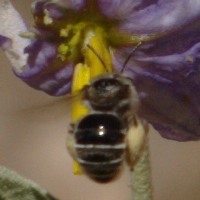
Exomalopsis solani is a species of bee in the family Apidae. It is found in Central America and North America.

Meloetyphlus fuscatus, the blind blister beetle, is a species of blister beetle in the family Meloidae found in Central and South America. They are kleptoparasites of orchid bees and are entirely blind as adults. Unique among meloids, females do not lay their eggs near flowers, but rather within their hosts' nests.

Centris analis is a solitary, oil-collecting bee with a geographical range extending from Brazil to Mexico. C. analis is a small, fast-flying bee with an average head width of 3.21mm and 3.54mm for males and females, respectively. While most species of the genus Centris create burrows for nesting, C. analis and other species of the subgenus Heterocentris build nests in pre-existing cavities rather than in the ground. C. analis is a pollinator of many plant species, especially of those in the family Malpighiaceae, which has encouraged its application in acerola orchards.






















